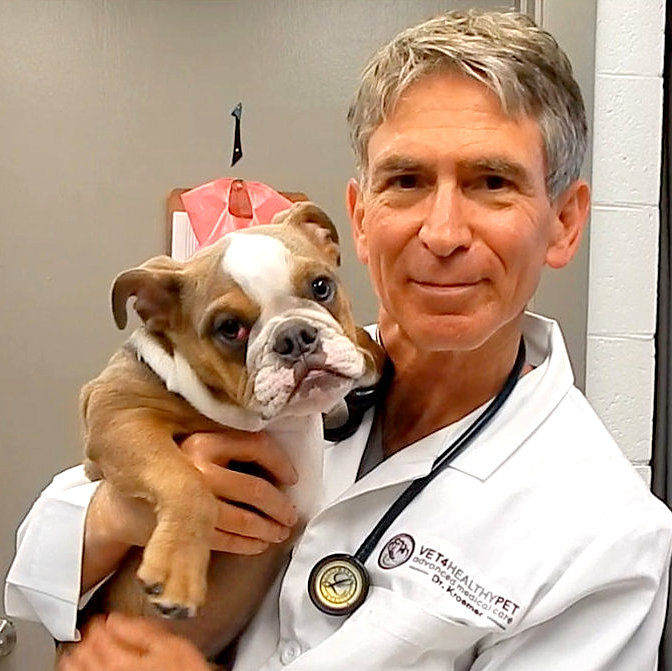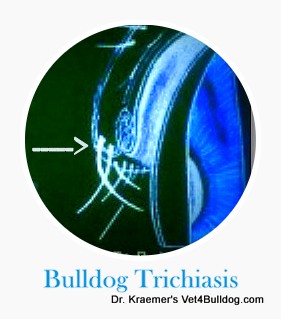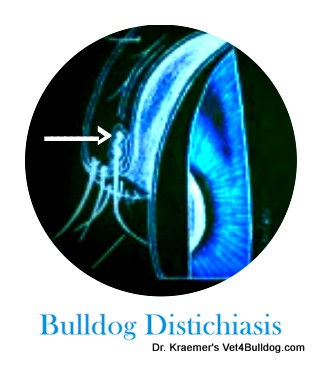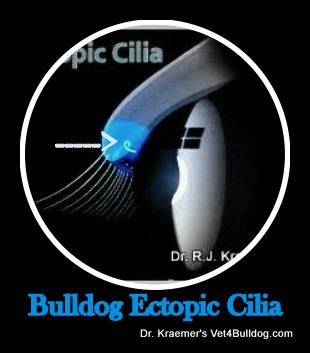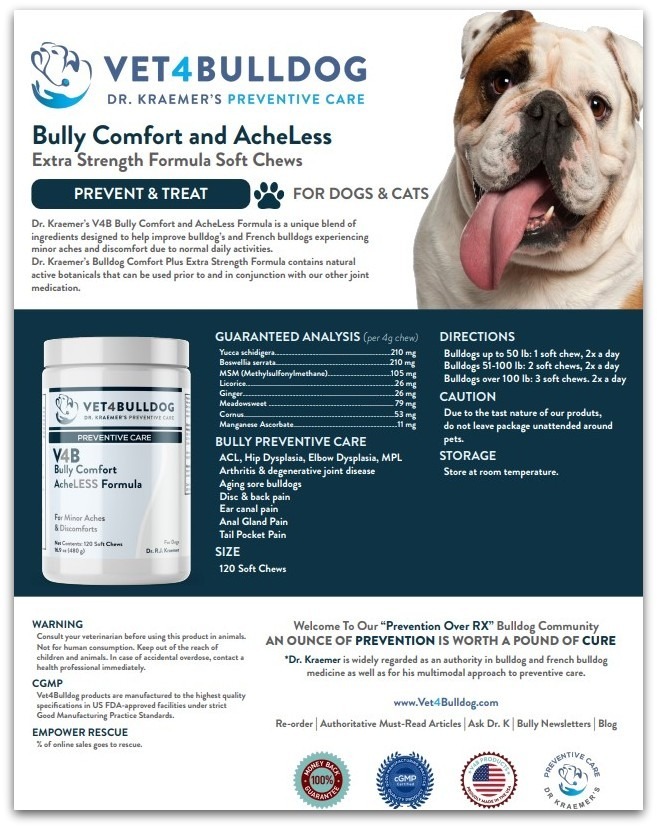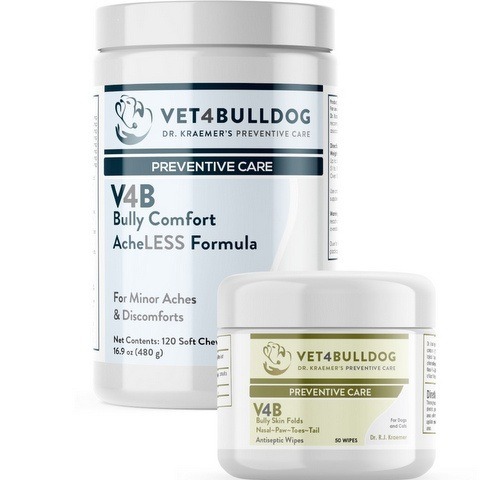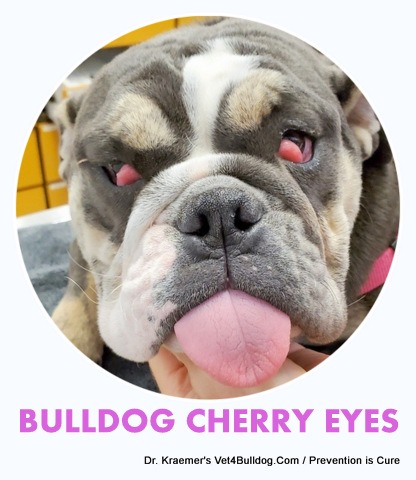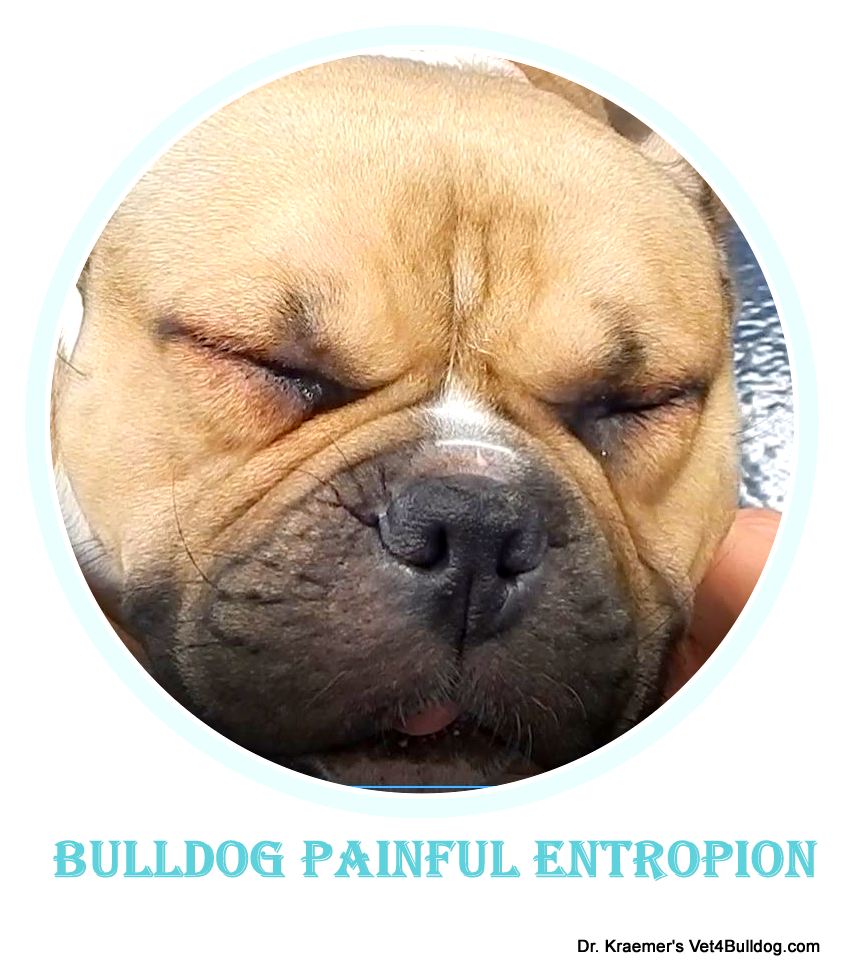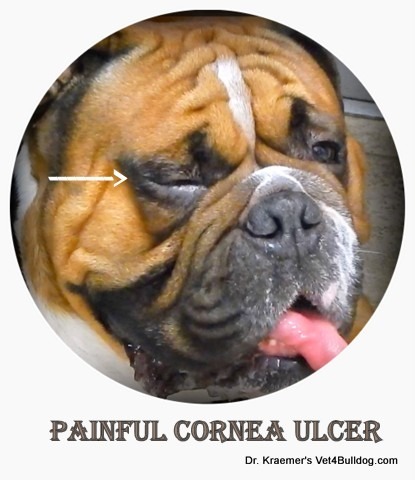Dr Kraemer Oink, my 2-year-old Fr bulldog, has a painful red eye, blinking and squinting nonstop and trying to rub it. His vet tested him for dry eye 😭and ulcer but could not find anything. I need to see you ASAP🩺 ? Anything you can recommend till then?
Thank you!❤️#BulldogVet #EyeRubbing #EyePain
Introduction To Abnormal Eyelash Leading to Corneal Ulcers in Bulldogs
Distichiasis, Distichiae, Trichiasis, and Ectopic Cilia are common eyelash disorders in bulldogs.
These abnormal eyelashes may grow from an unusual location on the eyelid or in an irregular direction, often leading to irritation, pain, discomfort, and potential damage to the eye.
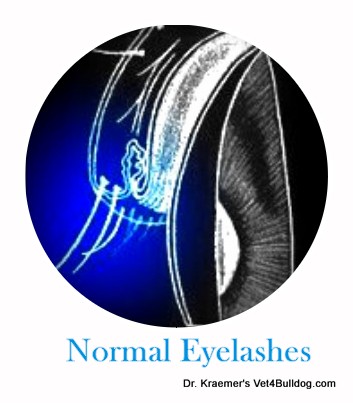
Most Common Abnormal Eyelash in Bulldogs and French Bulldogs
There are three common abnormal eyelashes in bulldogs
#1> BULLDOG TRICHIASIS
Bulldogs and French Bulldogs Trichiasis is an eyelash that grows from the right location but in an abnormal orientation. Instead of growing away from the eyeball, it grows toward the eyeball (cornea).
Trichiasis: is an eyelash gorowing from a normal eylid loction but in abnormal inward direction
#2> BULLDOG DISTICHIASIS
Distichiae in bulldogs refers to abnormal eyelashes that grow from an unusual location. Unlike normal eyelashes that emerge from the outer eyelid, distichiae grow from the inner eyelid, typically arising from the meibomian gland. These misplaced lashes can cause irritation, discomfort, and potential eye damage.
Distichiasis: eyelashes growing from an abnormal eyelid location
#3> BULLDOG ECTOPIC CILIA
Similar to distichiasis, ectopic cilia in bulldogs emerge from an abnormal location deeper inside the eyelid, near the conjunctiva. These misplaced eyelashes are typically stiff, pointy, and sometimes curled, often causing significant irritation or corneal damage.
Ectopic Cilia is an stiff pointy curled eyelash growing in an abnormal loction
Bulldog Eyelashe Disorder 5 X MUST KNOW
- Eyelash disorders are unique to bulldogs, the most common of which are distchiasis, trichiasis, and ectopic cilia
- The ingrown or abnormal eyelash rubs the cornea, causing pain and potential corneal injuries
- Bulldog eyelash disorders are often missed and best diagnosed with proper light and magnification.
- Repearing them often requires cryofreezing or surgical removal
- Prevention and care include Dr. Kraemer’s Bulldog Ophthalmic Bundles.
Members of this bulldog community prefer prevention over RX
Meibomian Glands in Bulldogs and French Bulldogs
The meibomian glands are tiny sebaceous glands embedded in your bulldog’s eyelids. They secrete an oily substance that plays a crucial role in maintaining a healthy tear film.
Your bulldog’s tear film consists of three essential layers:
➡️ Aqueous layer – produced by the tear glands
➡️ Lipid (oily) layer – produced by the meibomian glands
➡️ Mucoid layer – helps stabilize the tear film
Bulldog and French Bulldog KCS (Dry Eye)
A deficiency in any of these layers—especially the lipid, mucoid, or aqueous components—can lead to bulldog dry eye (keratoconjunctivitis sicca or KCS), a common condition that affects tear production and eye health.

Meibomian Tumors in Bulldogs
Meibomian tumors in bulldogs typically appear as swollen, bumpy growths on the eyelid margins.
They are more common in older bulldogs and are usually benign adenomas, meaning they grow slowly and rarely spread. However, these tumors should be removed if they:
- Irritating or rubbing against the cornea
- Grow significantly in size
- Start bleeding or ulcerating
Bulldog Disticha and Distichiasis Must Know
🚨 There is often more than one bulldog distichia growing across the eyelid
🚨 More than one bulldog distichia can be found in the same meibomian gland
🚨 Distichiae is most often found in the upper lid, but it can also be found growing from the meibomian gland of the lower lid.
🚨 Bulldogs Distichiae can be found simultaneously in their bottom and upper eyelids and on their left and right eyelids
The reason why the eyelash follicles develop in this abnormal location is not known
Symptoms of Abnormal Eyelashes in Bulldogs and Fr. Bulldogs
Abnormal eyelashes in bulldogs can cause significant eye discomfort, leading to secondary complications. C
Common symptoms include:
1. Eye Discharge
- Excessive tearing and mucus production
- Often due to corneal irritation and, in some cases, infection
2. Squinting & Rubbing
- The abnormal eyelashes make painful contact with the cornea
- Bulldogs may rub their eyes frequently or squint to relieve discomfort
3. Redness & Inflammation
- Conjunctivitis (red, irritated inner eyelids)
- Scleritis (inflammation of the white part of the eye)
- Puffy, swollen eyelids
4. Corneal Ulcers & Damage
- Corneal cloudiness or hyperpigmentation
- Blue or white opaque lesions
- Blood vessels growing over the cornea (vascularization)
5. Pain & discomfort:
Pain severity depends on:
- The stiffness of the abnormal eyelashes
- The number of abnormal lashes
- The extent of corneal contact
Diagnosis of Eyelash Disorders and Corneal Ulcers in Bulldogs and French Bulldogs
The proper diagnosis of abnormal eyelashes and corneal ulcers in bulldogs requires a thorough ophthalmic examination.
1. 🩺 Ophthalmic Exam
A complete eye examination should be performed to assess the eyelids, eyelashes, and cornea.
2. 🩺 Magnification & Illumination
Some abnormal eyelashes are easily visible, while others are thin, colorless, and difficult to detect with the naked eye. Diagnosis often requires magnification and proper illumination for accurate detection.
Sedation may be needed if the bulldog is in pain, blinking excessively, moving its head, or feeling anxious.
3. 🩺 Corneal Staining
Fluorescein staining should always be performed to rule out (r/o) corneal ulcers, which are common in bulldogs with abnormal eyelashes.

4. 🩺 Schirmer Tear Test (STT)
The Schirmer Tear Test (STT) is recommended to check for tear deficiency (KCS).
Keratoconjunctivitis sicca (KCS or dry eye) is common in bulldogs and can worsen corneal damage
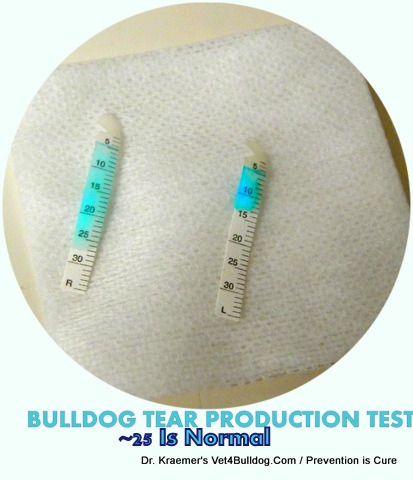
How to Treat Eyelash Disorders in Bulldogs and French Bulldogs?
You can take the wait & see approach
➡️ Abnormal eyelashes are sometimes detected incidentally during a routine exam.
➡️ If no discomfort or corneal contact is observed, immediate treatment may not be necessary.
➡️ Ophthalmic lubricants can be used as a protective barrier.
➡️ If elective surgery (e.g., spay/neuter) is planned, abnormal eyelashes can be removed and cryofrozen at that time.
#1 Eyelash Manual Plucking
Abnormal eyelashes can be plucked out using fine forceps.
⚠️ Warnings: It can be difficult to perform on restless or anxious dogs due to potential injury.
⚠️Custion: plucking is only a temporary solution; the hair is likely to regrow, often stiffer and more irritating than before.

#2 Eyelash Cryotherapy (Cryoepilation)
Liquid nitrogen cryopen is used to freeze and destroy the hair follicle, helping to prevent regrowth of abnormal eyelashes.
🚨 Cryoepilation usually requires sedation or general anesthesia
🚨Electrolysis requires sedation or general anesthesia
#4. Eyelash Surgical Removal
Rarely recommended, as it involves dissecting the gland and follicle.
#5. Entropion Surgery
If entropion (inward-rolling eyelids) is present, a surgical correction is highly recommended
Entropion surgery helps to rotate the eyelids outward, reducing future distichia regrowth and corneal irritation.

#6. Supportive Topical Treatments
- Lubricants: To protect the cornea.
- Antibacterial Drops/Ointments: To prevent infection.
- Pain Relief: To reduce discomfort.
#7. Corneal Ulcer Healing
- Hyaluronic Acid Ointment
- Serum
- PRP (platelet-rich plasma) can promote faster healing.

#8. Pain Management
- NSAIDs: For inflammation and pain relief.
- Bull Therapeutic Supplements: Such as Dr. Kraemer’s V4B Bully Comfort & AchLess Formula Chews for long-term joint and eye comfort.
Bulldog Abnormal Eyelash and Corneal Ulcers TIPS & WARNINGS
Below are essential eyelid and eyelash tips and warnings courtesy of Dr. kraemer
#1: 🩺 Use an E-Collar Tip
- Keep a buster or e-collar in place until the abnormal eyelash is removed.
- Continue post-operatively, if needed, to prevent rubbing and pawing at the eye.
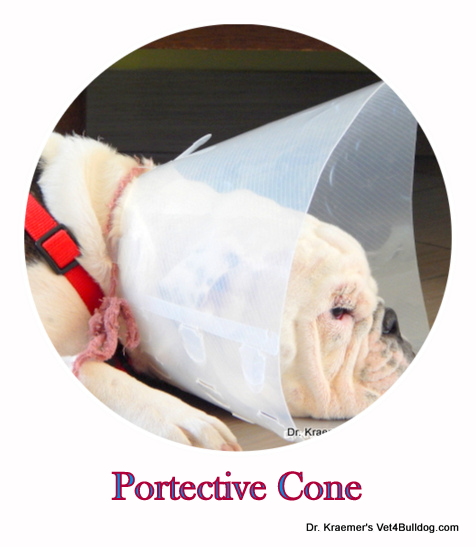
#2🩺 Eye Opthalmic Topical Medicine Tip:
Use topical ophthalmic medications short-term to reduce pain, promote corneal healing, and combat bacteria.
#3 🩺Pain Relief Rx and Bulldog Supplements Tip:
Implement pain control prescriptions (RX) and consider supplements to aid in overall comfort and healing.
#4 🩺Thorough Eye Examination Tip:
- Always inspect the eyelids for abnormally ingrown eyelashes during any eye exam.
- Many abnormal eyelashes in Bulldogs are light-colored and thin, making them easy to miss.
- Use a magnifying headlight and view from different angles to ensure a complete evaluation.
In my exam room I always inspect bulldog’s eyelids with a magnifying head light from different angles.
#1⚠️ The Need for Eye Magnification & Illumination Warning:
- Bulldog distichiasis is difficult to detect with the naked eye.
- A magnifying glass and proper illumination are essential for accurate diagnosis.
#2 ⚠️Veterinary Doctor Error Warning:
Since distichiasis is breed-specific (bulldogs and French bulldogs), many veterinarians may fail to check for it or miss the condition entirely.
#3 ⚠️ Breeding Bulldogs and Fr. Bulldog Warning:
Because abnormal eyelashes are hereditary, bulldogs with a history of eyelash disorders should not be bred.
#4 ⚠️ Potential Eyelid Scarring Warning:
Electrocautery and cryosurgery may lead to excessive scarring, potentially affecting eyelid function.
#5 ⚠️: Eyelash Regrowth & Repeat Procedures Warning:
Treated glands may still regrow abnormal hairs.
Other previously unaffected glands may start producing abnormal eyelashes later, requiring repeat procedures.
#6 ⚠️Ectopic Cilia Hidden Threat Warning:
Bulldog ectopic cilia (abnormal eyelashes growing from the inside of the eyelid) are:
- Extremely painful
- Difficult to detect (very short and deep inside the lid)
- Highly damaging to the cornea
Surgical removal is required ASAP to prevent severe corneal injury.
#7 ⚠️ Bulldog Entropion Complications Warning:
Bulldog entropion (inward-rolling eyelids) worsens distichiasis, increasing corneal trauma and discomfort.
#8 ⚠️ Risk of Eye Loss Warning:
Untreated, chronic bulldog distichiasis can result in:
- Severe corneal ulcers
- Infected, melting, or perforated ulcers
- Tragic loss of the eye if left untreated.
#9 ⚠️ Corneal Scarring & Vision Loss Warning:
Chronic corneal irritation from distichiasis or untreated ulcers can lead to:
- White opaque scars
- Fibrotic red scarring
- Black spots, cloudiness, and blood vessel formation over the cornea
- Permanent vision impairment
#10: ⚠️Eyes Rubbing & Itching – Other Causes Warning:
- Facial rubbing and itching can also be caused by:
- Bulldog allergies
- Bulldog and French bulldog skinfold dermatitis
Proper diagnosis is essential to help differentiate between eye irritation and allergy-related itching. To manage these conditions, consider:
- allergy control medications
- topical treatments
- Antiseptic skinfold wipes
Recommnded by Owners Approved by Bulldogs



